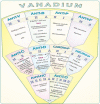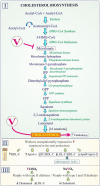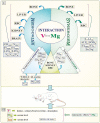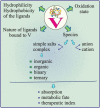Vanadium: Risks and possible benefits in the light of a comprehensive overview of its pharmacotoxicological mechanisms and multi-applications with a summary of further research trends
- PMID: 32305626
- PMCID: PMC7152879
- DOI: 10.1016/j.jtemb.2020.126508
Vanadium: Risks and possible benefits in the light of a comprehensive overview of its pharmacotoxicological mechanisms and multi-applications with a summary of further research trends
Abstract
Background: Vanadium (V) is an element with a wide range of effects on the mammalian organism. The ability of this metal to form organometallic compounds has contributed to the increase in the number of studies on the multidirectional biological activity of its various organic complexes in view of their application in medicine.
Objective: This review aims at summarizing the current state of knowledge of the pharmacological potential of V and the mechanisms underlying its anti-viral, anti-bacterial, anti-parasitic, anti-fungal, anti-cancer, anti-diabetic, anti-hypercholesterolemic, cardioprotective, and neuroprotective activity as well as the mechanisms of appetite regulation related to the possibility of using this element in the treatment of obesity. The toxicological potential of V and the mechanisms of its toxic action, which have not been sufficiently recognized yet, as well as key information about the essentiality of this metal, its physiological role, and metabolism with certain aspects on the timeline is collected as well. The report also aims to review the use of V in the implantology and industrial sectors emphasizing the human health hazard as well as collect data on the directions of further research on V and its interactions with Mg along with their character.
Results and conclusions: Multidirectional studies on V have shown that further analyses are still required for this element to be used as a metallodrug in the fight against certain life-threatening diseases. Studies on interactions of V with Mg, which showed that both elements are able to modulate the response in an interactive manner are needed as well, as the results of such investigations may help not only in recognizing new markers of V toxicity and clarify the underlying interactive mechanism between them, thus improving the medical application of the metals against modern-age diseases, but also they may help in development of principles of effective protection of humans against environmental/occupational V exposure.
Keywords: 3-HMG-CoA, 3-hydroxy-3-methyl-glutaryl-CoA; AIDS, acquired immune deficiency syndrome; ALB, albumin; ALP, alkaline phosphatase; AS, antioxidant status; Akt, protein kinase B (PKB); AmD, Assoc American Dietetic Association; Anti-B, anti-bacterial; Anti-C, anti-cancer; Anti-D, anti-diabetic; Anti-F, anti-fungal; Anti-O, anti-obesity; Anti-P, anti-parasitic; Anti-V, anti-viral; Anti−HC, anti-hypercholesterolemic; ApoA-I, apolipoprotein A; ApoB, apolipoprotein B; B, bone; BCOV, bis(curcumino)oxavanadyl; BEOV, bis(ethylmaltolato)oxovanadium; BMOV, bis(maltolato)oxavanadium(IV); Bim, Blc-2 interacting mediator of cell death; Biological role; BrOP, bromoperoxidase; C, cholesterol; C/EBPα, CCAAT-enhancer-binding protein α; CD4, CD4 receptor; CH, cerebral hemisphere; CHO-K1, Chinese hamster ovary cells; CXCR-4, CXCR-4 chemokine co-receptor; Cardio-P, cardioprotective; Citrate-T, citrate transporter; CoA, coenzyme A; Cyt c, cytochrome c; DM, diabetes mellitus; ELI, extra low interstitial; ERK, extracellular regulated kinase; FHR, fructose hypertensive rats; FKHR/FKHR1/AFX, class O members of the forkhead transcription factor family; FLIP, FLICE-inhibitory protein; FOXOs, forkhead box class O family member proteins; FPP, farnesyl-pyrophosphate; FasL, Fas ligand, FER: ferritin; GI, gastrointestinal; GLU, glucose; GLUT-4, glucose transporter type 4; GPP, geranyl-pyrophosphate; GPT, glutamate-pyruvate transaminase; GR, glutathione reductase; GSH, reduced glutathione; GSSG, disulfide glutathione; HDL, high-density lipoproteins; HDL-C, HDL cholesterol; HIV, human immunodeficiency virus; HMMF, high molecular mass fraction; HOMA-IR, insulin resistance index; Hb, hemoglobin; HbF, hemoglobin fraction; Hyper-LEP, hyperleptynemia; IDDM, insulin-dependent diabetes mellitus; IGF-IR, insulin-like growth factor receptor; IL, interleukin; INS, insulin; INS-R, insulin resistance; INS-S, insulin sensitivity; IPP, isopentenyl-5-pyrophosphate; IRS, insulin receptor tyrosine kinase substrate; IgG, immunoglobulin G; Industrial importance; Interactions; JAK2, Janus kinase 2; K, kidney; L, liver; L-AA, L-ascorbic acid; LDL, low-density lipoproteins; LDL-C, LDL cholesterol; LEP, leptin; LEP-R, leptin resistance; LEP-S, leptin sensitivity; LEPS, the concentration of leptin in the serum; LMMF, low molecular mass fraction; LPL, lipoprotein lipase; LPO, lipid peroxidation; Lactate-T, lactate transporter; M, mitochondrion; MEK, ERK kinase activator; MRC, mitochondrial respiratory chain; NAC, N-acetylcysteine; NEP, neutral endopeptidase; NIDDM, noninsulin-dependent diabetes mellitus; NO, nitric oxide; NPY, neuropeptide Y; NaVO3, sodium metavanadate; Neuro-P, neuroprotective; OXPHOS, oxidative phosphorylation; Organic-AT, organic anion transporter; Over-W, over-weight; P, plasma; PANC-1, pancreatic ductal adenocarcinoma cells; PARP, poly (ADP-ribose) polymerase; PLGA, (Poly)Lactide-co-Glycolide copolymer; PO43−, phosphate ion; PPARγ, peroxisome-activated receptor γ; PTK, tyrosine protein kinase; PTP, protein tyrosine phosphatase; PTP-1B, protein tyrosine phosphatase 1B; Pharmacological activity; Pi3K, phosphoinositide 3-kinase (phosphatidylinositol 3-kinase); RBC, erythrocytes; ROS, reactive oxygen species; RT, reverse transcriptase; SARS, severe acute respiratory syndrome; SAcP, acid phosphatase secreted by Leshmania; SC-Ti-6Al-4V, surface-coated Ti-6Al-4V; SHR, spontaneously hypertensive rats; SOD, superoxide dismutase; STAT3, signal transducer/activator of transcription 3; Sa, mean roughness; Sq, root mean square roughness; Sz, ten-point height; TC, total cholesterol; TG, triglycerides; TS, transferrin saturation; Tf, transferrin; TfF, transferrin fraction; TiO2, nHA:Ag-Ti-6Al-4V: titanium oxide-based coating containing hydroxyapatite nanoparticle and silver particles; Top-IB, IB type topoisomerase; Toxicological potential; V, vanadium; V-BrPO, vanadium bromoperoxidase; V-DLC, diamond-like layer with vanadium; V5+/V4+, pentavalent/tetravalent vanadium; VO2+, vanadyl cation; VO2+-FER, vanadyl-ferritin complex; VO4-/VO3-, vanadate anion; VO43-, vanadate ion; VS, vanadyl sulfate; Vanadium; WB, whole blood; ZDF rats, Zucker diabetic fatty rats; ZF rats, Zucker fatty rats; breakD, breakdown; eNOS, endothelial nitric oxide synthase; mo, months; n-HA, nano-hydroxyapatite; pRb, retinoblastoma protein; wk, weeks.
© 2020 Elsevier GmbH. All rights reserved.
Conflict of interest statement
The authors declare that they have no known competing financial interests or personal relationships that could have appeared to influence the work reported in this paper.
Figures





















Similar articles
-
Clinical efficacies, underlying mechanisms and molecular targets of Chinese medicines for diabetic nephropathy treatment and management.Acta Pharm Sin B. 2021 Sep;11(9):2749-2767. doi: 10.1016/j.apsb.2020.12.020. Epub 2021 Feb 2. Acta Pharm Sin B. 2021. PMID: 34589395 Free PMC article. Review.
-
Effect of Korean Red Ginseng on metabolic syndrome.J Ginseng Res. 2021 May;45(3):380-389. doi: 10.1016/j.jgr.2020.11.002. Epub 2020 Nov 12. J Ginseng Res. 2021. PMID: 34025131 Free PMC article. Review.
-
Mas receptor: a potential strategy in the management of ischemic cardiovascular diseases.Cell Cycle. 2023 Jul;22(13):1654-1674. doi: 10.1080/15384101.2023.2228089. Epub 2023 Jun 26. Cell Cycle. 2023. PMID: 37365840 Free PMC article. Review.
-
Differences in plasma homocysteine levels between Zucker fatty and Zucker diabetic fatty rats following 3 weeks oral administration of organic vanadium compounds.J Trace Elem Med Biol. 2006;19(4):251-8. doi: 10.1016/j.jtemb.2005.10.001. Epub 2005 Dec 13. J Trace Elem Med Biol. 2006. PMID: 16443173
-
Preparation and characterization of vanadyl complexes with bidentate maltol-type ligands; in vivo comparisons of anti-diabetic therapeutic potential.J Biol Inorg Chem. 2003 Jan;8(1-2):66-74. doi: 10.1007/s00775-002-0388-5. Epub 2002 Sep 12. J Biol Inorg Chem. 2003. PMID: 12459900
Cited by
-
Association between Plasma Trace Element Concentrations in Early Pregnancy and Gestational Diabetes Mellitus in Shanghai, China.Nutrients. 2022 Dec 27;15(1):115. doi: 10.3390/nu15010115. Nutrients. 2022. PMID: 36615774 Free PMC article.
-
Spectroscopic/Computational Characterization and the X-ray Structure of the Adduct of the VIVO-Picolinato Complex with RNase A.Inorg Chem. 2021 Dec 20;60(24):19098-19109. doi: 10.1021/acs.inorgchem.1c02912. Epub 2021 Nov 30. Inorg Chem. 2021. PMID: 34847328 Free PMC article.
-
Vanadium as potential therapeutic agent for COVID-19: A focus on its antiviral, antiinflamatory, and antihyperglycemic effects.J Trace Elem Med Biol. 2022 Jan;69:126887. doi: 10.1016/j.jtemb.2021.126887. Epub 2021 Oct 29. J Trace Elem Med Biol. 2022. PMID: 34798510 Free PMC article. Review.
-
Micronutrient Deficiency May Be Associated with the Onset of Chalkbrood Disease in Honey Bees.Insects. 2024 Apr 12;15(4):269. doi: 10.3390/insects15040269. Insects. 2024. PMID: 38667399 Free PMC article.
-
Metals and Metal Complexes in Diseases with a Focus on COVID-19: Facts and Opinions.Biology (Basel). 2023 Jun 15;12(6):868. doi: 10.3390/biology12060868. Biology (Basel). 2023. PMID: 37372151 Free PMC article.
References
-
- Nriagu J.O. Part 2: Health Effects. John Wiley and Sons; New York: 1998. Vanadium in the environment.
-
- Tracey A.S., Willsky G.R., Takeuchi E.S. CRC Press, Taylor and Francis Group; 2007. Vanadium: Chemistry, Biochemistry, Pharmacological, and Practical Applications.
-
- Zaporowska H., Ścibior A. Hematological effects of vanadium on living organisms. In: Nriagu J.O., editor. Vol. 31. John Wiley and Sons; New York, Chichester, Weinheim, Brisbane, Singapore, Toronto: 1998. pp. 135–157. (Vanadium in the Environment. Part 2: Health Effects).
Publication types
MeSH terms
Substances
LinkOut - more resources
Full Text Sources
Research Materials
Miscellaneous

